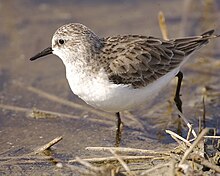Pygmy sandpiper
| Pygmy sandpiper | ||||||||
|---|---|---|---|---|---|---|---|---|

Pygmy sandpiper ( Calidris minuta ) |
||||||||
| Systematics | ||||||||
|
||||||||
| Scientific name | ||||||||
| Calidris minuta | ||||||||
| ( Leisler , 1812) |
The sparrow-sized pygmy sandpiper ( Calidris minuta ) is a monotypical species from the family of snipe birds (Scolopacidae) and is one of the world's smallest wading birds. It breeds in northern Eurasia. In Central Europe it can be regularly observed both on the North Sea coast and inland during migration times .
Appearance
The bird's magnificent dress has a rust-red top with fine black dots on the head and chest. The underside is white. The legs are black (the very similar Temminck sandpiper has yellow legs). The plain dress is a uniform gray. The sandpiper is 12-14 cm long and has a wingspan of 28-31 cm. It can weigh 20 to 30 g.
distribution
The migratory bird breeds in northern Scandinavia and in the Siberian tundra . The main area of distribution is on the Taymyr Peninsula . The pygmy sandpiper is a long-distance migrant. He spends the winter in the Mediterranean region, in the Middle East and in Central and South Africa. The largest number overwinters in Africa. There are also a small number of wintering birds in the North Sea. The pygmy sandpipers that cross or hibernate Europe or hibernate their wintering quarters in the Black Sea, the Mediterranean region and in North and West Africa are probably all European breeding birds. The individuals that winter in the Caspis region, the Middle East and East, and South Africa are believed to be West Siberian breeding birds.
habitat
The pygmy sandpiper breeds in damp places or on the coast of the Arctic and subarctic. Most of the time he is near freshwater pools. During migration and in winter, it prefers to stay on silt, sand and mud areas without vegetation on the coast and in inland waters. Sometimes he also uses small bodies of water.
Mating and breeding
The females are successive bigamists and reproduce with two males during one breeding season. Two clutches are created, the first of which is incubated by the first male and the second by the female. The breeding season begins in June. The main laying time is in the second half of June. The clutch size averages four eggs. These are oval to top-shaped and have whitish, light olive, violet-brown, dark brown and gray-violet speckles and blobs. The breeding period is twenty to 21 days.
The animals can live up to 12 years.
supporting documents
literature
- Hans-Günther Bauer, Einhard Bezzel and Wolfgang Fiedler (eds.): The compendium of birds in Central Europe: Everything about biology, endangerment and protection. Volume 1: Nonpasseriformes - non-sparrow birds. Aula-Verlag Wiebelsheim, Wiesbaden 2005, ISBN 3-89104-647-2 .
- Simon Delany, Derek Scott, Tim Dodman, David Stroud (Eds.): An Atlas of Wader Populations in Africa and Western Eurasia. Wetlands International , Wageningen 2009, ISBN 978-90-5882-047-1 .
Web links
- Calidris minuta in the endangered Red List species the IUCN 2008. Posted by: BirdLife International, 2008. Accessed on December 19 of 2008.
- Videos, photos and sound recordings for Calidris minuta in the Internet Bird Collection
- Age and gender characteristics of Spanish migrants (PDF; 1.2 MB) by J. Blasco-Zumeta and G.-M. Heinze (Eng.)
- Feathers of the pygmy sandpiper




